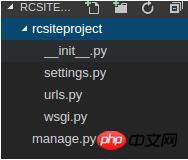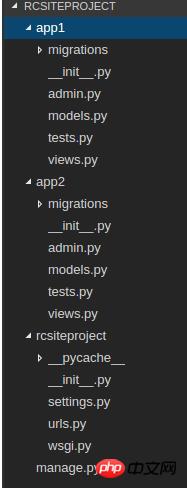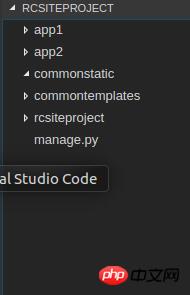
这篇文章主要介绍了多个应用共存的Django配置方法,有着一定的参考价值,现在分享给大家,有需要的朋友可以参考一下
1.配置环境
安装python3 安装python3-pip 通过pip安装Django **如果需要使用Jinja模板,需要通过pip安装django-jinja与jinja2**
2. 新建Django工程
django-admin startproject rcsiteproject
其目录结构如下图所示:

3.新建app
python3 manage.py startapp app1 python3 manage.py startapp app2

4.配置app的urls
在每个app中新建urls文件

在rcsiteproject中的urls.py文件包含每个app的url。
urlpatterns = [ url(r'^admin/', include(admin.site.urls)), url(r'^app1/', include('app1.urls')), url(r'^app2/', include('app2.urls')), ]
5.配置setting.py
INSTALLED_APPS = ( 'django.contrib.admin', 'django.contrib.auth', 'django.contrib.contenttypes', 'django.contrib.sessions', 'django.contrib.messages', 'django.contrib.staticfiles', 'app1', 'app2' )
6.添加文件中共同引用的commontemplates与commonstatic文件夹

在setting中配置static及template
HERE = os.path.dirname(os.path.dirname(__file__)) MEDIA_ROOT = os.path.join( HERE ,'media').replace('\\','/') MEDIA_URL = '/media/' STATIC_ROOT = os.path.join(HERE,'static').replace('\\','/') STATIC_URL = '/static/' STATICFILES_DIRS = ( # add other path no app static os.path.join(HERE,'commonstatic/').replace('\\','/'), )
配置templates ‘DIRS'.
TEMPLATES = [
{
'BACKEND': 'django.template.backends.django.DjangoTemplates',
'DIRS': [(os.path.join(BASE_DIR, 'commontemplates')),],
'APP_DIRS': True,
'OPTIONS': {
'context_processors': [
'django.template.context_processors.debug',
'django.template.context_processors.request',
'django.contrib.auth.context_processors.auth',
'django.contrib.messages.context_processors.messages',
],
},
},7.配置template Jinja2解析
INSTALLED_APPS = [ 'django_jinja' ]
TEMPLATES = [
{
"BACKEND": "django_jinja.backend.Jinja2",
'DIRS': [(os.path.join(BASE_DIR, 'commontemplates')),],
"APP_DIRS": True,
"OPTIONS": {
"app_dirname": "templates",
"match_extension": ".html",
}
},
{
'BACKEND': 'django.template.backends.django.DjangoTemplates',
'DIRS': [(os.path.join(BASE_DIR, 'commontemplates')),],
'APP_DIRS': True,
'OPTIONS': {
'context_processors': [
'django.template.context_processors.debug',
'django.template.context_processors.request',
'django.contrib.auth.context_processors.auth',
'django.contrib.messages.context_processors.messages',
],
},
},
]上述文章有什么不之处,欢迎大家指正。
相关推荐:
Das obige ist der detaillierte Inhalt vonDjango-Konfigurationsmethode für die Koexistenz mehrerer Anwendungen. Für weitere Informationen folgen Sie bitte anderen verwandten Artikeln auf der PHP chinesischen Website!
 Standardpasswort des Routers
Standardpasswort des Routers
 So ersetzen Sie ppt-Hintergrundbilder einheitlich
So ersetzen Sie ppt-Hintergrundbilder einheitlich
 Der Unterschied zwischen recv und recvfrom
Der Unterschied zwischen recv und recvfrom
 So erhalten Sie die Adresse der Adressleiste
So erhalten Sie die Adresse der Adressleiste
 Drei Möglichkeiten, einen Thread in Java zu beenden
Drei Möglichkeiten, einen Thread in Java zu beenden
 So lösen Sie das Problem der langsamen Übertragung von Serverdomänennamen
So lösen Sie das Problem der langsamen Übertragung von Serverdomänennamen
 Was bedeutet Handy-HD?
Was bedeutet Handy-HD?
 Welche Datentypen gibt es?
Welche Datentypen gibt es?




